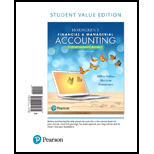
Statement of
Direct method: This method uses the basis of cash for preparing the cash flows statement.
Cash flows from operating activities: In this direct method, cash flow from operating activities is computed by using all cash receipts and cash payments during the year.
Cash Receipts: It encompasses all the cash receipts from sale of goods and on
Cash Payments: It encompasses all the cash payments that are made to suppliers of goods and all expenses that are paid.
The below table shows the way of calculation of cash flows from operating activities:
| Cash flows from operating activities (Direct method) |
| Add: Cash receipts. |
| Cash receipt from customer |
| Less: Cash payments: |
| To supplier |
| For operating expenses |
| Income tax expenses |
| Net cash provided from or used by operating activities |
To Compute: Cash flows from operating activities using direct method.
Want to see the full answer?
Check out a sample textbook solution
Chapter 14 Solutions
Horngren's Financial & Managerial Accounting, The Managerial Chapters, Student Value Edition Plus MyLab Accounting with Pearson eText -- Access Card Package (6th Edition)
- What amount should be reported on the balance sheet for inventory of this general accounting question?arrow_forwardMichael is a 40% partner in the Juno Partnership. At the beginning of the tax year, Michael's basis in the partnership interest was $80,000, including his share of partnership liabilities. During the current year, Juno reported an ordinary income of $50,000. In addition, Juno distributed $7,500 to each of the partners ($22,500 total). At the end of the year, Michael's share of partnership liabilities increased by $15,000. What is Michael's basis in the partnership interest at the end of the year?arrow_forwardFinancial Accounting Question please solve this onearrow_forward
- Tech Solutions, Inc. is looking to achieve a net income of 18 percent of sales. Here’s the firm’s profile: Unit sales price is $12; variable cost per unit is $7; total fixed costs are $50,000. What is the level of sales in units required to achieve a net income of 18 percent of sales?arrow_forwardAccurate answerarrow_forward??arrow_forward
- Helparrow_forwardThe Suit Factory sells suits. Currently, it sells 20,000 suits annually at an average price of $150 each. It is considering adding a lower-priced line of suits that sell for $120 each. The firm estimates it can sell 8,000 of the lower-priced suits but will sell 3,000 fewer of the higher-priced suits by doing so. What is the amount of the sales that should be used when evaluating the addition of the lower-priced suits? A. $510,000 B. $420,000 C. $605,000 D. $530,000arrow_forwardWhat is level of accounts receivable?arrow_forward

 AccountingAccountingISBN:9781337272094Author:WARREN, Carl S., Reeve, James M., Duchac, Jonathan E.Publisher:Cengage Learning,
AccountingAccountingISBN:9781337272094Author:WARREN, Carl S., Reeve, James M., Duchac, Jonathan E.Publisher:Cengage Learning, Accounting Information SystemsAccountingISBN:9781337619202Author:Hall, James A.Publisher:Cengage Learning,
Accounting Information SystemsAccountingISBN:9781337619202Author:Hall, James A.Publisher:Cengage Learning, Horngren's Cost Accounting: A Managerial Emphasis...AccountingISBN:9780134475585Author:Srikant M. Datar, Madhav V. RajanPublisher:PEARSON
Horngren's Cost Accounting: A Managerial Emphasis...AccountingISBN:9780134475585Author:Srikant M. Datar, Madhav V. RajanPublisher:PEARSON Intermediate AccountingAccountingISBN:9781259722660Author:J. David Spiceland, Mark W. Nelson, Wayne M ThomasPublisher:McGraw-Hill Education
Intermediate AccountingAccountingISBN:9781259722660Author:J. David Spiceland, Mark W. Nelson, Wayne M ThomasPublisher:McGraw-Hill Education Financial and Managerial AccountingAccountingISBN:9781259726705Author:John J Wild, Ken W. Shaw, Barbara Chiappetta Fundamental Accounting PrinciplesPublisher:McGraw-Hill Education
Financial and Managerial AccountingAccountingISBN:9781259726705Author:John J Wild, Ken W. Shaw, Barbara Chiappetta Fundamental Accounting PrinciplesPublisher:McGraw-Hill Education





